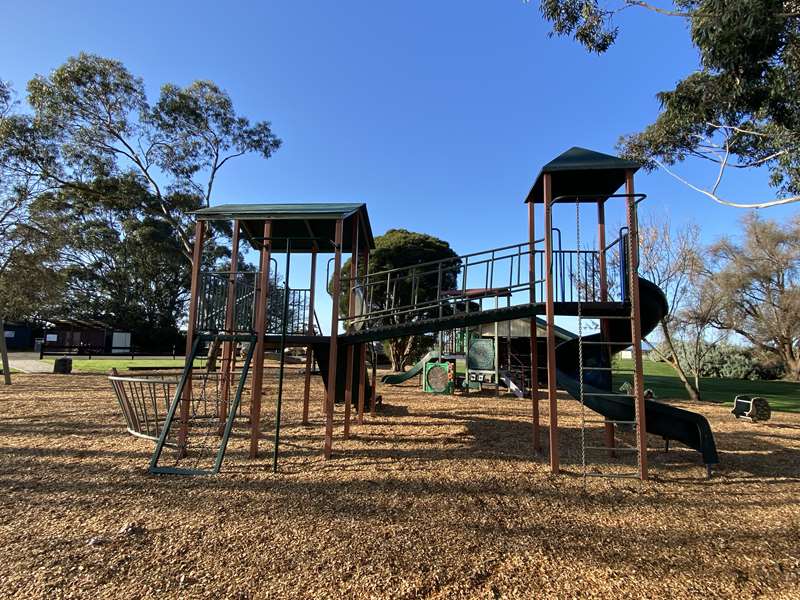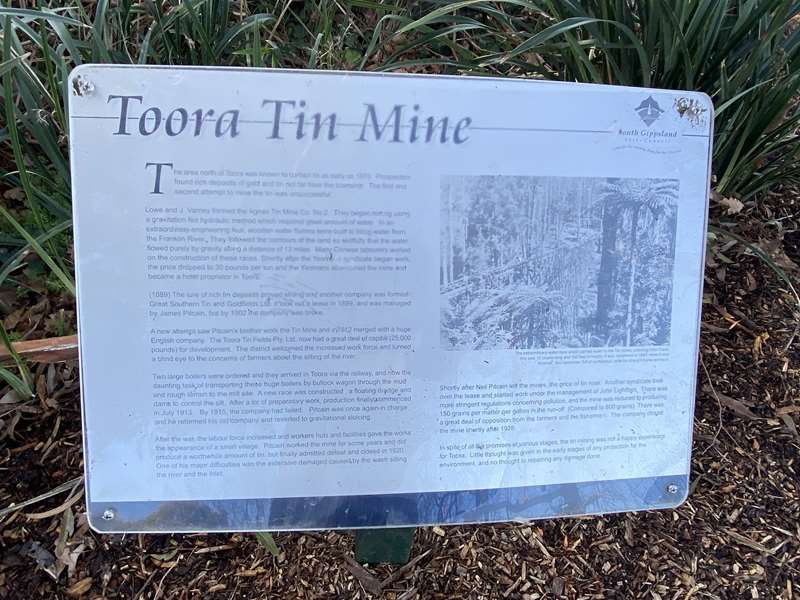Sagasser Park Playground, Toora Jetty Road, Toora


The playground is next to the Great Southern Rail Trail. The play structure for older kids is in the shape of a boat and has a spiral ladder, high suspended chain ladder, inclined walkway, steps, chain ladder, and fireman's pole.
The structure for younger kids has a curved slide, shopfront, steering wheel panel, distorting mirror, steps, maze panel, little straight slide and some other panel games.
Also a stand-on spinning disk, two swings, pommel bounce, echidna springer, horse springer and plastic basketball "net". A big fallen tree has climbing holds and a slide.
Shelter with table, seats and BBQs, another shelter with a table, some grassy area, old horse trough, water tap, unshaded seat, information on Toora windfarm, and toilets. Nearby, there is a skatepark.
Beside the playground is a nice garden with information signs about the district.
Toora Tin Mine

The area north of Toora was known to contain tin as early as 1873. Prospectors found rich deposits of gold and tin not far from the township. The first and second attempt to mine the tin was unsuccessful.
Lowe and J Varney formed the Agnes Tin Mine Co No. 2. They began mining using a gravitation fed hydraulic method which required great amount of water. In an extraordinary engineering feat, wooden water flumes were built to bring water from the Franklin River. They followed the contours of the land so skillfully that the water flowed purely by gravity along a distance of 13 miles. Many Chinese labourers worked on the construction of these races. Shortly after the Yeoman's syndicate began work, the price dropped to 30 pounds per ton and the Yeomans abandoned the mine and became a hotel proprietor in Toora.
(1889) The lure of rich tin deposits proved proved strong and another company was formed Great Southern Tin and Goldfields Ltd. It took out a lease in 1899, and was managed by James Pitcain, but by 1902 the Company was broke.
A new attempt saw Pitcain's brother work the Tin Mine and in 1912 merged with a huge English company The Toora Tin Fields Pty. Ltd, now had a great deal of capital (25,000 pounds) for development. The district welcomed the increased work force and turned a blind eye to the concerns of farmers about the silting of the river.
Two large boilers were ordered and they arrived in Toora via the railway, and now the daunting task of transporting these huge boilers by bullock wagon through the mud and rough terrain to the mill site. A new race was constructed, a floating dredge and dams to control the silt. After a lot of preparatory work, production finally commenced in July 1913. By 1915 the company had failed. Pitcain was once again in charge and he reformed his old company and reverted to gravitational sluicing.
After the war, the labour force increased and workers huts and facilities gave the works the appearance of a small village. Pitcain worked the mine for some years and did produce a worthwhile amount of tin, but finally admitted defeat and closed in 1920. One of his major difficulties was the extensive damage caused by the wash silting the river and the Inlet.
Shortly after Neil Pitcain left the mines, the price of tin rose. Another syndicate took over the lease and started work under the management of John Lightfoot. There was more stringent regulations concerning pollution, and the mine was reduced to producing 150 grains per matter per gallon in the run-off (Compared to 800grains). There was a great deal of opposition from the farmers and the fishermen. The company closed the mine shortly after 1928.
In spite of all the promises at various stages, the tin mining was not a happy experience for Toora. Little thought was given in the early stages of any protection for the environment, and no thought to repairing any damage done.
Toora Tin Mine
Before the turn of the century, Toora Beach played an important part in the development of the area. Buchanan's timber mill required a means to dispatch large quantities of timber. With no roads, he relied on shipping and built a tramline in 1861 between Muddy Creek and Swan Bay, north of Toora Beach, where he built a small pier. Horse-drawn carriages carried the timber along this line. which was loaded onto barges and towed by small paddle steamers to deeper water and loaded onto larger steamers.
The timber tramline would sink into the mud and another line would be laid on top. This line was later used by Great Southern Railway construction crews to bring in supplies and equipment including the locomotive "Ivanhoe". The entire supply of rails for the third section of rail line between Toora and Port Albert was unloaded at Swan Bay.
1880 saw a need for a larger jetty and the Progress Association persuaded the Government in 1899 to build a new jetty:- 700 feet long, 8 feet wide with a fan shaped end costing 2000 pounds. In 1907 a low loading deck and shed was also added.
The jetty was used for many years by fishermen, and to bring supplies in and out of the region. It was the site for the very popular Toora picnics enjoyed by the whole district. Increased use of the railway system meant that the Toora jetty did not receive recognition as a shipping centre and therefore struggled for funding.
Electricity
During the early 1900's the residents of Toora decided it was time to do away with the nightly task of lighting kerosene lamps and dark streets and sought ways to obtain a supply of electricity. In July 1911, a company was formed (Toora Electric Light and Power Supply Co. Ltd) with James Allan as Chairman, to install a Hydro electric plant on the Franklin River at Kewita. A tender from James Summers of Toora was accepted for the erection of the powerhouse, poles and machinery. August 1911, application was made through the Govt. Gazette to supply and sell electricity for public and private use to Toora and other parts of the Shire of South Gippsland. However due to some errors of judgment the work was abandoned.
In 1912, the company arranged the installation of a suction gas plant at the Toora Butter factory to supply electricity to Toora houses. This gas plant failed due to financial difficulties and a new company (Toora & Foster Electricity Scheme) was formed to establish a new hydro scheme on the Franklin River. This new venture called for subscribers and on completion of a tunnel to divert the water to the powerhouse, and a newspaper article dated June 7th, 1916 reported that power plant was completed and trial run was satisfactory. However, supply of electricity was erratic depending on demand and the flow of the river. A dam was built which improved the flow of water but silting after heavy rain affected the machinery.
In 1920, Harold Lasseter (who lived in Toora for some time) proposed to construct a hydro-electric plant at Agnes Falls as the river had a superior flow. This scheme did not eventuate. Lack of supply problems continued, silting from the Tin Mine was increasing and even with the introduction of an auxiliary plant in 1933, supply problems still persisted. The options were to either update the plant with large capital outlays, or to seek supplies from the newly formed State Government scheme which used power generated from brown coal at Yallourn. Several South Gippsland towns were already connected to the new State Electricity Scheme and Toora was lent some additional equipment until the S.E.C. finally took over the Toora company in 1938.
In 1991, the original Shire of South Gippsland was approached by various firms to establish a windfarm on Silcock's Hill overlooking the township of Toora. Construction of this $39 million project was completed in 2002 by Stanwell Corporation, an Australian company.
Timber
This entire region was densely covered by rainforest. The huge timbers proved to be a formidable obstacle for early travellers and the first task for settlers was to clear the land. This clearing of the land was the start of a very prosperous timber industry and many mills were established in the region. As often the only means of transporting the logs was by bullock dray, many of the mills were built close to timber supplies. One such mill was located on the bank of the Franklin River, close to the present cemetery, by Septimus Martin.
In 1860 the Buchanan Brothers obtained 640 acres at Toora and secured a contract for supplying railway sleepers to India. They established a mill near Muddy Creek. A settlement of huts was built for the mill workers and their families. One such family was the McGleads from Ireland whose dependents reside in Foster.
As roads were virtually non existent, the mill output was taken by tramline to Swan Bay and loaded onto ships. The gold boom led to a building surge in Melbourne and timber prices were high. When demand for timber slackened and timber prices dropped, the cost of cutting and transporting to market were huge. Buchanan found the mill unviable but it continued operate on a limited basis under the control of Peter McMillan. The empty huts were maintained and even used for overnight accommodation for travellers. When the land was taken over by Stanley Shepard, he demolished them to save paying rates to the Alberton Shire.
Older residents recall stories that tell of logs being transported by a cable operated carrier that slung the logs over the very difficult terrain between Silcock's Hill and the Toora mill.
Dairying
Often the settlers in the further hills would be mud bound for winter and early spring, so it was essential for them to get their supplies of flour, sugar, and tea before the wet months set in.
The earliest settlers had various ways of disposing of their meagre produce. The womenfolk helped with the milking, set the milk in wide pans, and skimmed off the cream to make salted butter which was then packed to the towns, the tin mine or rail gangs.
By 1891, hand separators were appearing and in 1893 Toora had a cheese factory. Horse drawn wagons collected milk or cream from the farmers and drivers took out bread, provisions and produce as a complimentary service.
Among our early settlers was a Mr. Benjamin Richards who, in 1877, selected a property about two miles from the town known as "Kewita". Mr Richards established a dairy of 600 cows. As milking machines were unknown, all the milking was done by hand. His shed accommodated 120 cows at a time and housed a huge separator, churns and a butter worker, all steam operated. Dairying went on to become the mainstay of our region.
Photos:
Location
26 Toora Jetty Road, Toora 3962 View Map








